Guides • Understanding Publishing
Posted on Apr 16, 2025
How to Publish a Children's Book (and Actually Make Money)
The Reedsy Network
Reedsy's publishing freelancers come from all over the world and specialize in various disciplines, from editing to design.
View profile →This post is written by Karen Inglis, bestselling author of The Secret Lake and Children’s Advisor at the Alliance of Independent Authors.
There's nothing quite like crafting stories that captivate, educate, and inspire children around the globe. But how do you consistently publish children's books successfully — and even make a career out of it?
Over my more than a decade-long career, I've published a range of picture books, chapter books and middle-grade novels through my independent imprint, Well Said Press, each selling in their thousands. My time-travel adventure, The Secret Lake, has sold over 600,000 copies in English and has been translated into 14 languages.
How do I achieve this? By following an 8-step blueprint which I share below. (If you find this useful and want to dive even deeper, I’ve written a nonfiction book on the subject called ‘How to Self-publish and Market a Children’s Book’).
How to publish a children’s book in 8 steps:
1. Understand the children’s book market
One of the most common mistakes to avoid when starting out with your first children’s book is not knowing what age group it is aimed at. Understanding this is crucial because it affects not just what you write, but also how you write it 一 the story’s themes, use of language, plot complexity, story and chapter length, and age of key characters. (Tip: children prefer main characters to be their own age or ideally a bit older!)
However, it’s not just about the story. Over 90% of your children’s book sales will be in print, and your reader’s age will also influence your book’s physical dimensions as well as its interior and exterior formatting choices. These include typeface, font size, line spacing, left or full justification, paper color, and the number and style of any illustrations.
Determine the age group you’re writing for
Here's a breakdown of children's book age groups (for ages 3 and above), along with typical page counts and illustration styles:
|
Age Group |
Book Type |
Word Count |
Page Count |
Illustrations |
|---|---|---|---|---|
|
3-5 years |
Picture Book |
200-1000 words |
24-32 |
Full colour on every page |
|
5-7 years |
Early Reader |
1000-3,500 words |
32-64 |
Colour or b&w, on most pages |
|
7-10 years |
Chapter Book |
5,000-15,000 words |
48-100 |
B&W illustrations (scattered) |
|
8-12 years |
Middle Grade |
25,000-50,000 words |
120-300 |
Few or no illustrations (B&W if present) |
Provided you have a good story, sticking close to these lengths and formats will help set you up for success when marketing your book alongside the competition, both online and in bookshops.
But feel free to take some creative liberties
The above said, there is always room for flexibility! The Secret Lake is 22,400 words and its sequels are 52,000 and 62,000 words respectively! Henry Haynes and the Great Escape runs to 5,000 words and is best for ages 6-7, and The Tell-Me Tree has been used in schools for ages 4-8 owing to its theme of helping children share feelings. Don’t ruin your story by trying to stay rigid to the numbers above, but if you’re going to deviate, be sure that you have a well-written and cracking read, or content that justifies bucking the norm.
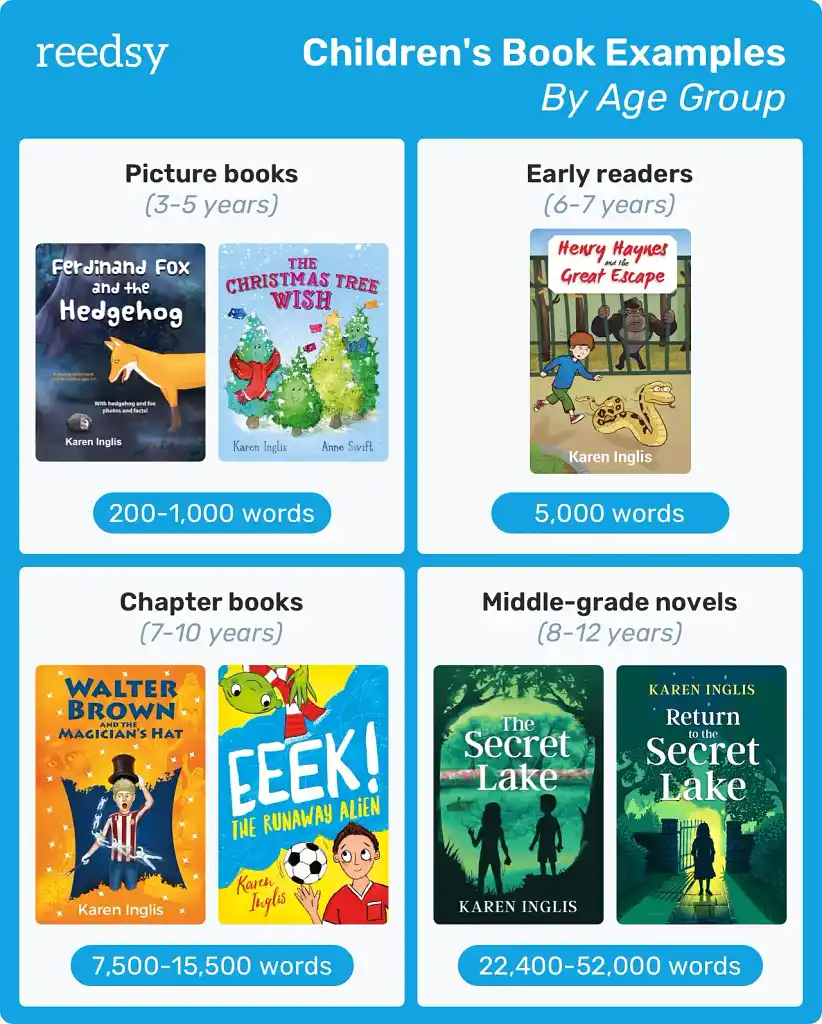
Explore a wide range of children’s literature
My biggest tip when starting out is to visit your local children’s library or bookshop and buy or borrow and start reading around. If you’ve just the kernel of an idea for a story, or even a fully mapped out idea in your head, where might it fit in this landscape? What will that look like on paper?
If you don’t yet have a story idea, worry not 一 reading around will provide plenty of inspiration! As a particular genre draws you in, read more of it to get familiar with the plotlines and themes, characterization, humor and use of language 一 and illustration style if relevant. This should help with your first draft…
2. Write your first draft and gather feedback
To write a successful children's book, you’ll need to follow the same storytelling principles as adult fiction. You’ll need:
- A compelling story premise
- Relatable characters (even if flawed)
- A central goal or challenge (internal or external)
- Setbacks along the way (internal or external)
- Satisfying resolution
- Character growth or change
For example, in The Secret Lake, Stella is bored of the new gardens they have moved to and is missing her best friend back in Hong Kong. But a lost dog leads to a hidden time tunnel and a whole new adventure that takes her into the past with her brother Tom. Here they meet the children living in their past-time home and overcome a series of challenges to rescue and clear the name of a young boy who has been falsely accused of theft. By the end of the story Stella has forged new friends across time, recognized the power of bravery and loyalty in those around her, and grown to see the gardens and her new home in a whole new light.
Next, what matters is that you tell your story in a way that fits the age and stage of your reader.
Tailor your language for your readers
If your language is too simple or too advanced, readers will quickly disengage. That said, it’s fine to introduce unfamiliar vocabulary — children enjoy learning new words — just ensure they can make an educated guess from the context. Also, make sure that children’s dialogue sounds like children! A very early mistake I made when starting out was including turns of phrase that only an adult would use – luckily my first editor pulled me up on that!
With picture books, use repetition and rhythm to help engage young audiences.
The reading from your early research will help you with all of the above.
Paint pictures with words
Use ‘show don’t tell’ to convey characters’ feelings and emotions, or what they see or hear. Don’t tell young readers that a character is scared, shy, or lonely; show us through their physical actions and reactions, their dialogue or their inner thoughts. (Of course, with picture books the illustrations will play a major role here 一 as seen in this extract from The Tell-Me Tree, where they do the heavy lifting.)
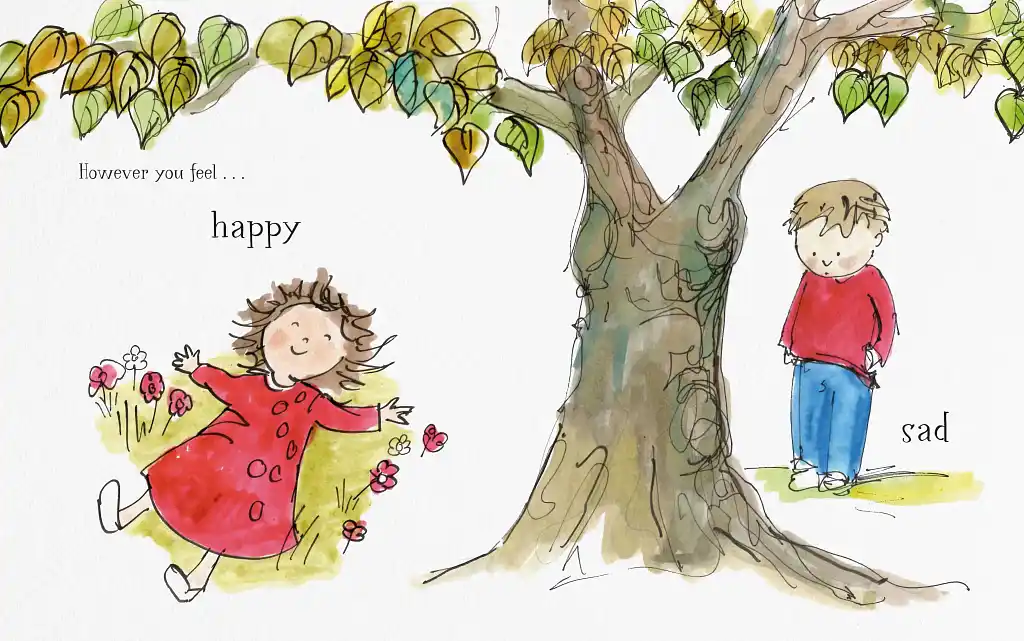
Test your story with beta readers
Once you feel your story is as good as it can be, your next step is to test it with young readers (or their parents/teachers for picture books). Approach your local library, children’s playgroup, or a teacher in your local school. Offer a free final copy of your book in return for honest feedback on your manuscript.
If it’s a picture book, don’t commission illustrations yet! Create a simple mock-up with dummy sketches created with free AI tools (more on this later). Four or five readers are enough to get feedback.
Polish and edit your book based on feedback. Professional editors come next, but first… you need to decide your publishing route.
3. Choose a publishing route
Print on demand, coupled with access to increasingly smart and cost-effective formatting tools, and teams of experienced freelance creatives, has accelerated professionalism in the world of self-publishing over the last 10 years. No longer is it viewed simply as ‘vanity publishing’. Thus we are lucky today to have two viable publishing options: traditional and self-publishing.
Whilst traditional publishing offers validation and (in some cases) easier access to high street bookshops — it’s highly competitive, slow-moving, and offers limited creative control. And even if you get a deal after many months or years, print book royalties are typically just 7.5% of the Recommended Retail Price (RRP) 一 or less where books are sold in bulk at a discount.
Self-publishing, by contrast, gives you creative control, the freedom to publish when you want, and higher earnings per sale — typically 25%-75% of the RRP for print books, depending on how you sell them. In 2021 I was offered a two-book traditional deal for The Secret Lake sequels — with reasonable advances. After crunching the numbers and fretting about the loss of control, I turned it down.
So should you self-publish your children’s book? Ultimately it’s your choice. Bear in mind that self-publishing is a business in which you take on the upfront cost and responsibility for production and, later on, marketing. This means you will need a budget 一 but it’s not as scary as it sounds! The rest of this post assumes you wish to self-publish.
4. Hire a professional children’s editor
Assuming your manuscript is ready and tested, and you plan to self-publish, your next step is to work with an experienced children’s book editor. A good editor will give you frank, informed feedback on your manuscript and teach you bucketloads about writing for children. What you will learn for your next book will be invaluable — trust me!
Where to find children’s book editors:
- Reedsy 一 search children’s book editors by genre and ask for a quote 一 all are vetted, and most have worked in the traditional publishing world. I used an excellent editor for Walter Brown and the Magician’s Hat
- The Society of Children’s Book Writers and Illustrators
- WritersAdvice.co.uk 一 I used them for The Secret Lake in its early days, and for early drafts of several other titles
Also ask fellow children’s authors for recommendations 一 or in social media groups frequented by children’s authors.
Hire an expert
Kim G.
Available to hire
Passionate writer, editor and proofreader with over 10 years in publishing. CIEP member specialising in children's fiction and adult factual
Kelly M.
Available to hire
I am a meticulous, passionate copy editor who specializes in YA fiction and cookbooks and has worked with Random House and Simon & Schuster.
Sara J.
Available to hire
Developmental editor, formerly at Penguin Random House, Harper Collins and Bloomsbury, and published author.
Compare quotes and go with your gut and budget. Cost will depend on the experience of the editor, your book’s length and the quality of your manuscript. I’ve personally paid between $650-$1,000 for my middle-grade novels, with pretty clean manuscripts. Picture book editing will of course come in lower owing to the short word count.
5. Collaborate with an illustrator
For picture books, your illustrator is your co-storyteller, so you’ll be looking for someone whose style matches the tone and emotional arc of your text. Hopefully your early research will have helped here. The same is true for chapter book illustration style.
Where to find illustrators:
- Reedsy
- The Society of Children’s Book Writers and Illustrators
- Children’s Illustrator Groups on Linked-In
Or search online. Again, remember to ask fellow authors for their recommendations.
Hire an expert
Mallette B.
Available to hire
Visual storyteller specializing in book cover illustrations for young adult and middle-grade fantasy.
Clare B.
Available to hire
Award winning art director and designer. Designing for Harry Potter, Game of Thrones, Warhol, Queen, DK, The Met New York and many more.
Judit T.
Available to hire
Currently cooking for US children's book publishers, mixing it with some storyboarding on the side and topping it with creative writing.
In my experience, costs for a book cover typically start at around $600 but could be a bit less or a lot more depending on style used and the illustrator’s experience. Illustrations for a 32-page color picture are likely to start at around $4,000 and go up to around $5,000.
Be intentional in your design brief
Most illustrators will not have time to read your middle-grade novel or chapter book. The clearer your brief the more likely they will capture the essence of your story early on. Here are a few tips to help smooth the process:
- Include examples of books you like in your illustrator brief, along with notes explaining what appeals to you 一 including color palette if that’s something you feel strongly about. Remember to check in thumbnail size!
- If you have an image or scene for your front cover that you’re finding hard to describe, are there any photos you could find online to make your brief clearer?
- Or why not use a free AI tool like ChatGPT or DALL-E via Bing to create a dummy sketch or scene?
- Include a text excerpt from your book if you think this will help the illustrator.
See below the crude mock-up and briefing text I provided using Canva for the cover for Return to the Secret Lake. (Note that at that time I hadn’t settled on the final title!)
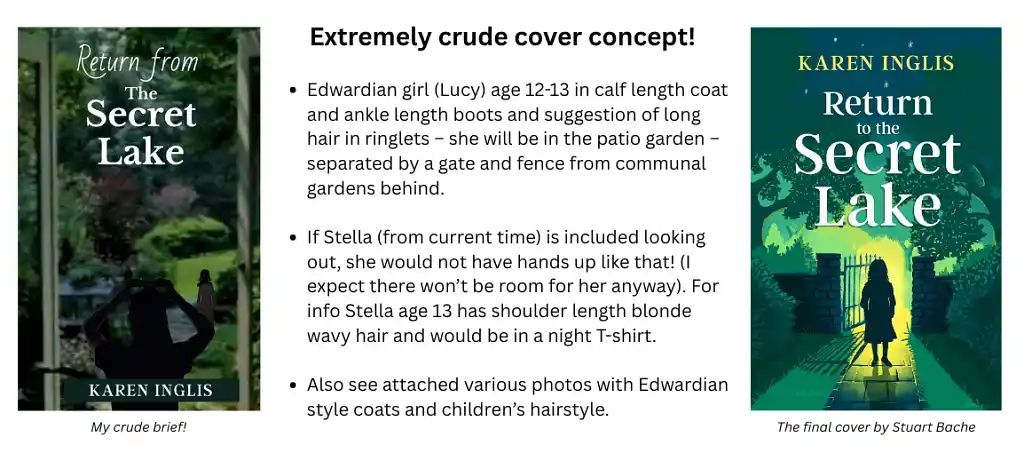
And here’s how I used both text and AI (DALL-E) to generate a crude AI image when briefing my illustrator Andrew Smith for Ferdinand Fox and the Lost Boy. You’ll find the final images underneath. (Note that I changed some of the text to fit the final image with the bin!)
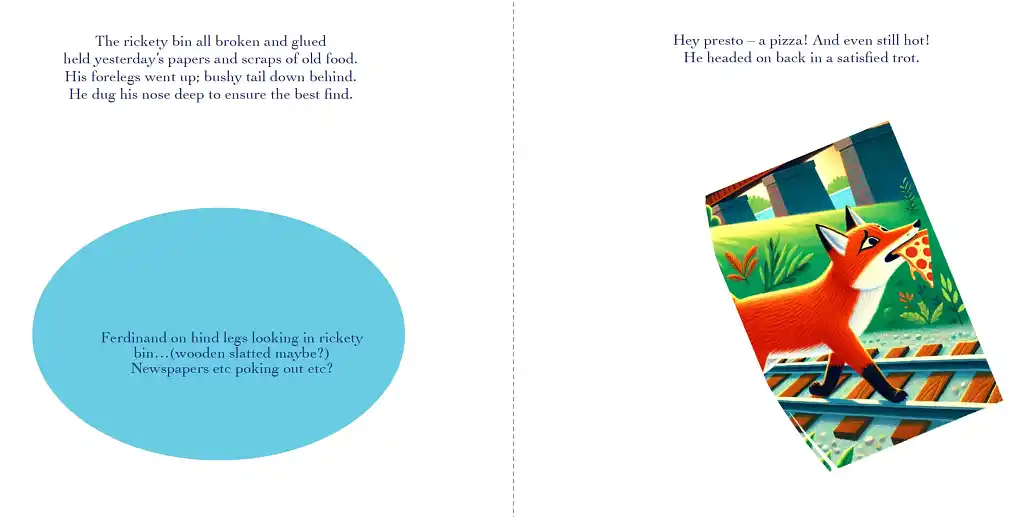
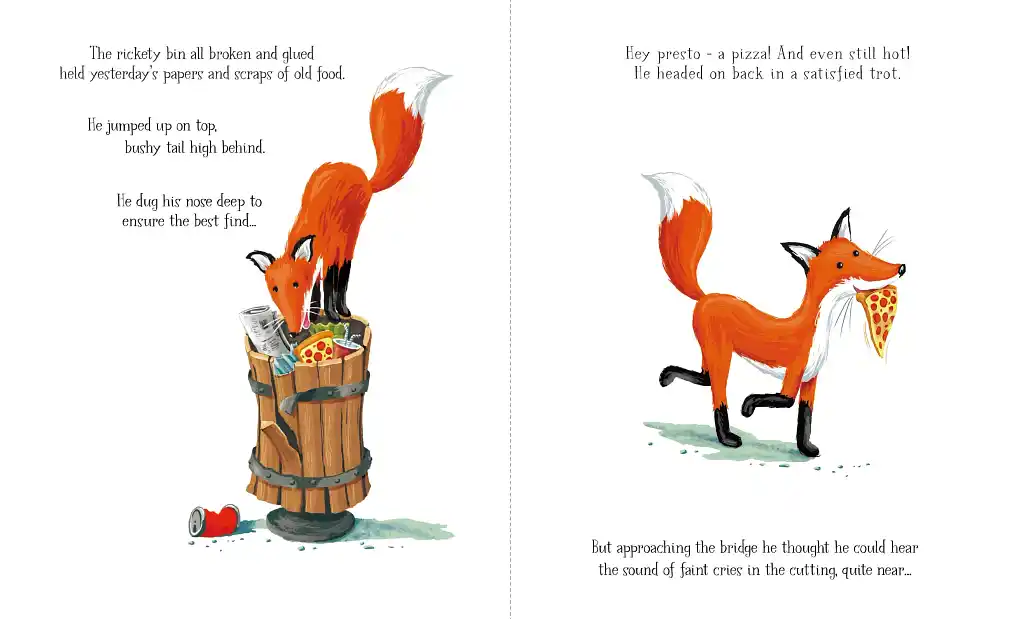
Get clarification about AI usage
Most digital illustrators these days use AI ethically to enhance their own work. But some generate 100% AI content and pass it off as original art. Include a clause in your agreement to prevent this if it matters to you. The costs should be significantly lower if illustrations are generated entirely from AI.
Seek to own the illustrations copyright
In traditional publishing, illustrators usually retain copyright and license the images to the publisher. If you're self-publishing, I recommend requesting full copyright ownership once the work is paid for, if possible. This gives you flexibility for marketing, merchandise, and future editions. Not all illustrators will wish to do this; if this is the case respect this and look elsewhere.
Search online for a simple form of words to use to assign copyright (or see my template text in my self-publishing book).
6. Format your book for print
Once your story is edited and proofread, you’ll need to decide on your trim size. You’re then ready to format your book and create print-ready files. Choose a trim size that closely matches books in your genre.
Trim sizes vary slightly between the US and UK, but stick to one size for both markets to avoid needing separate ISBNs. Similarly, if using more than one printer, which many authors do (see Step 7) make sure that the trim size you choose is available from them all. For the most common sizes they will be.
For my chapter books and middle-grade novels, I use 5.25 x 8 inches on cream paper. For my colour picture books I use 8 x 10 on white paper. I’ve seen other authors use 8.5 x 8.5 for picture books.
Once you have the trim size, how do you format the book?
Picture books: For interiors, I recommend outsourcing to a layout artist (search Reedsy or ask your illustrator) unless you have a good eye for design and are prepared to buy and learn new tools, or are going for a very simple design with text on one page and illustration opposite or similar.
For simple DIY layouts you could try Canva 一 you’ll need the paid option for print-ready files. (Search online for tutorials online from children’s authors who have used this with professional illustrations they have commissioned.) In the early days, I outsourced even my simple picture book layouts to a specialist I found online. This was before the days of Reedsy.
If you’re looking for something more adventurous and have budget and an eye for layout, look at Affinity Publisher. I used this to lay out my latest picture book, Ferdinand Fox and the Lost Boy, working closely with my illustrator ahead of time to ensure that the text placement would fit with the images.
Chapter Books and Middle Grade: For illustrated novels, I use Vellum ($249.99, Mac only) to format the interior, as it makes placing images for print really straightforward. Alternatively, Reedsy Studio is a great free tool if your print book doesn’t have illustrations. Font choices and size are limited but check it out for older MG if you’re on a tight budget.
For all covers, I recommend using your illustrator if they are experienced in this area, or a professional cover designer. They will understand all about fonts and handle all of the technicalities.
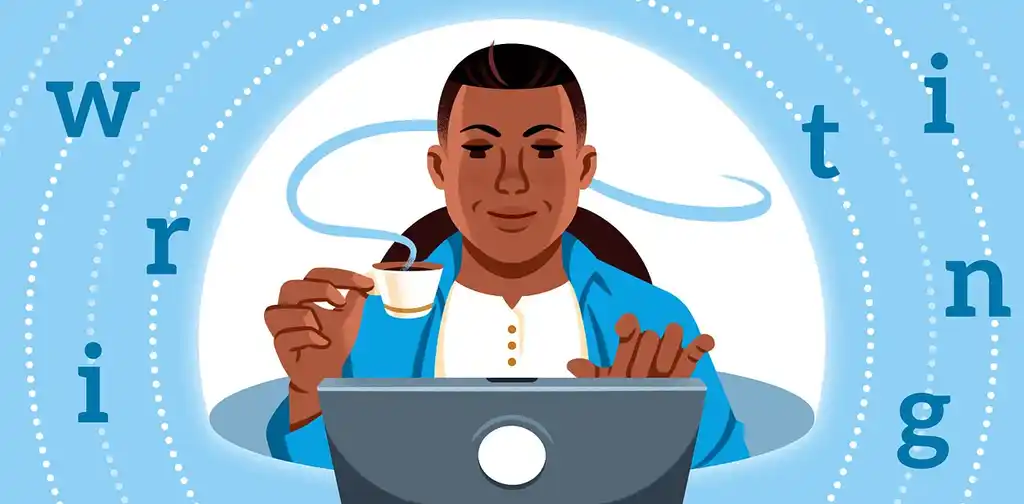
FREE FORMATTING APP
Reedsy Studio
Format your manuscript for print or EPUB with a single click.
7. Print and distribute your book
Here’s what I use for my own distribution and what I’d recommend for most children’s authors.
Get your own ISBN barcodes
I use my own ISBN bought from Nielsen UK. Each country has its own ISBN store and some, such as Canada and New Zealand, offer them for free. Search online to find yours. I don’t recommend accepting free ISBNs offered by distributors as that makes them and not you the ‘publisher of record’.
Distribute with KDP and IngramSpark
I use KDP Print for Amazon sales worldwide and I opt out of Expanded Distribution, as it pays lower royalties than Amazon sales and simply piggybacks on Ingram’s network, on which more below.
For non-Amazon sales worldwide I use IngramSpark with the same ISBN as for KDP (your cover file will differ in size slightly but your illustrator/cover designer will handle that). I get a better return with Ingram by going direct, choosing my wholesale discount and, if necessary, setting the RRP a little higher than for KDP.
Print author copies for live events
For my author copies of chapter books and middle-grade novels for events I use either KDP or Ingram Spark, whichever quote is cheaper for the number I need.
For my author copies of picture books to sell at school events or supply to local bookshops I use BookVault. Why not KDP/IngramSpark? Because BookVault offers coated paper finish at a very reasonable unit cost; around £2.13 ($2.70) for a 32-page colour picture book as I write.* This is a game changer for children’s authors as it closely matches the finish on traditionally published picture book interiors. I use the same ISBN and the same interior and cover files as for KDP.
*At the time of writing BookVault’s coated finish is only available from the UK. If you’re elsewhere, check lead time, customs tariffs and postage to see if it’s viable. Otherwise I’d check Lulu who also offers this finish, or see what local printers quote for short runs. Failing this, use KDP or Ingram. Their color picture books are fine but the thinner pages don’t compare with a silk finish.
8. Market your book strategically
Marketing is where many authors stumble — but it’s essential if you want your book to succeed. It was a long slog for me with The Secret Lake, but the hard work has definitely paid off!
Remember, Amazon ads weren’t available for self-published authors when The Secret Lake came out in 2011/12, and we didn’t have access to the plethora of social media sites and tools that exist today. Instead, over the course of the first five years, I sold around 7,000 print copies at local bookshop signings and school events all set up through my own efforts. This entailed many emails and phone calls and book shop visits, petrol and parking costs, and more than a few dead ends! But gradually it began to work, with word of mouth leading to more opportunities.
Face-to-face events also gave me the chance to ask teachers/parents to help their children leave reviews online which (very) slowly began to build and tickle Amazon’s algorithms. I also provided a review page on The Secret Lake’s own website where parents can help children leave reviews and where I always reply. I had to be careful to follow data protection rules, so it carries lots of warnings, but over time it has developed into its own time-tunnel!
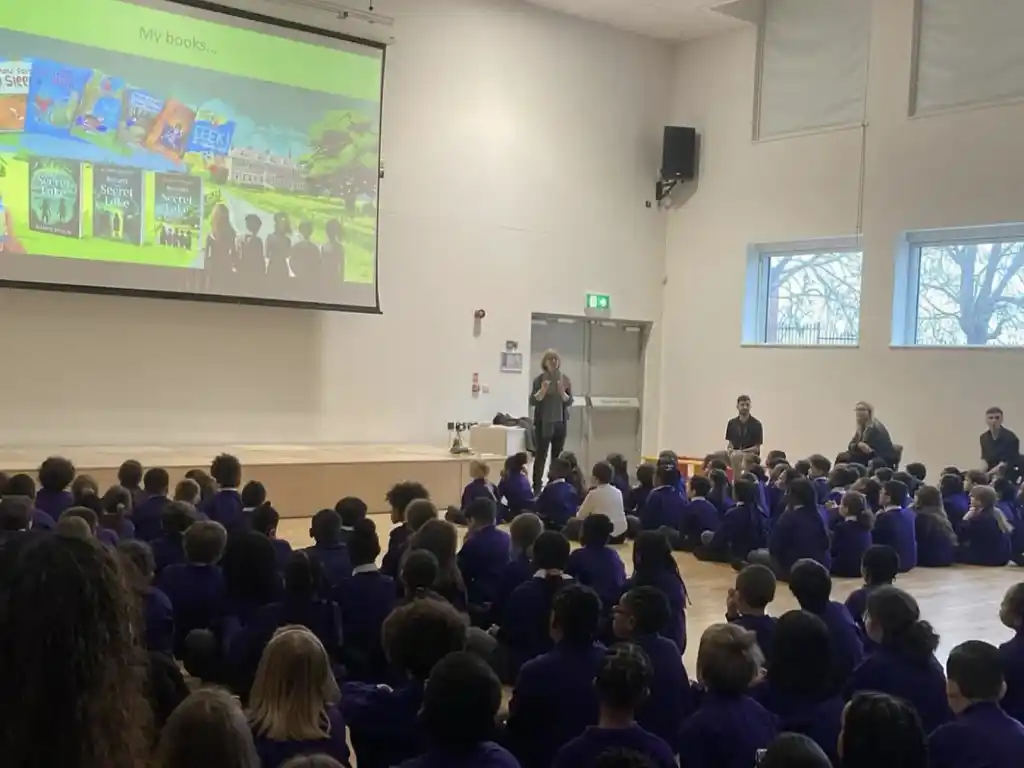
I do have to say that I believe it’s the story that has led to such phenomenal sales of The Secret Lake. This said, my other titles have all sold in their thousands (if not hundreds of thousands) and events have been the driver here, so you certainly don’t need a break-out bestseller in order to do well!
In short, don’t underestimate the power of face-to-face marketing alongside everything else. Human connection is more important than ever today and meeting and engaging directly with young readers is an absolute joy!
Follow these best practices
Here are some of my top tips for marketing your children’s book. Starting local and building out from there is key.
📆 Before launch:
- Have a page in your book asking readers to leave a review
- Set up a simple website (your author name is best) 一 this is your calling card
- Connect with local libraries, schools, and parents’ groups
🚀 At launch:
- Offer free school or library story time visits to gain early exposure, offer signed books for sale
- Contact your local press with a “local author” angle – our local paper did a large spread for The Secret Lake at launch owing to its connection to a stunning pond in Richmond Park
- Visit local bookshops and offer books on a sale-or-return basis
- Use Canva, BookBrush, or ChatGPT to create social media graphics — promote and tag local buying options as well as Amazon.
⭕ Ongoing:
- Be active on Instagram or your preferred platform — post regularly using reels, quotes, or visit photos, local press coverage
- Use relevant hashtags (e.g. #childrensbooks #WorldBookDay #summerreads)
- Create downloadable resources for teachers: quizzes, discussion guides, colouring pages – promote these on your website and in the back of your books
- Offer free resources in exchange for email sign-ups from parents/teachers
- Once you have a few school visits under your belt, start to charge
📢 Ads:
- Once your book has a few reviews, research using Amazon ads. Target books similar to yours and focus on relevant search terms. Test and adjust, and keep to a budget you can afford.
- I don’t recommend Facebook Ads for children’s authors unless you have money to burn on testing, or a book in a niche topic such as children’s mental health which would allow you to laser-target key audiences.
I have barely scratched the surface here! Above all, to make money with your children’s book, write a great story, produce it professionally, and put your heart and soul into marketing it. Again, for a deep dive, check out my book How to Self-publish and Market a Children’s Book. Most advice is evergreen, and a new edition is on its way!
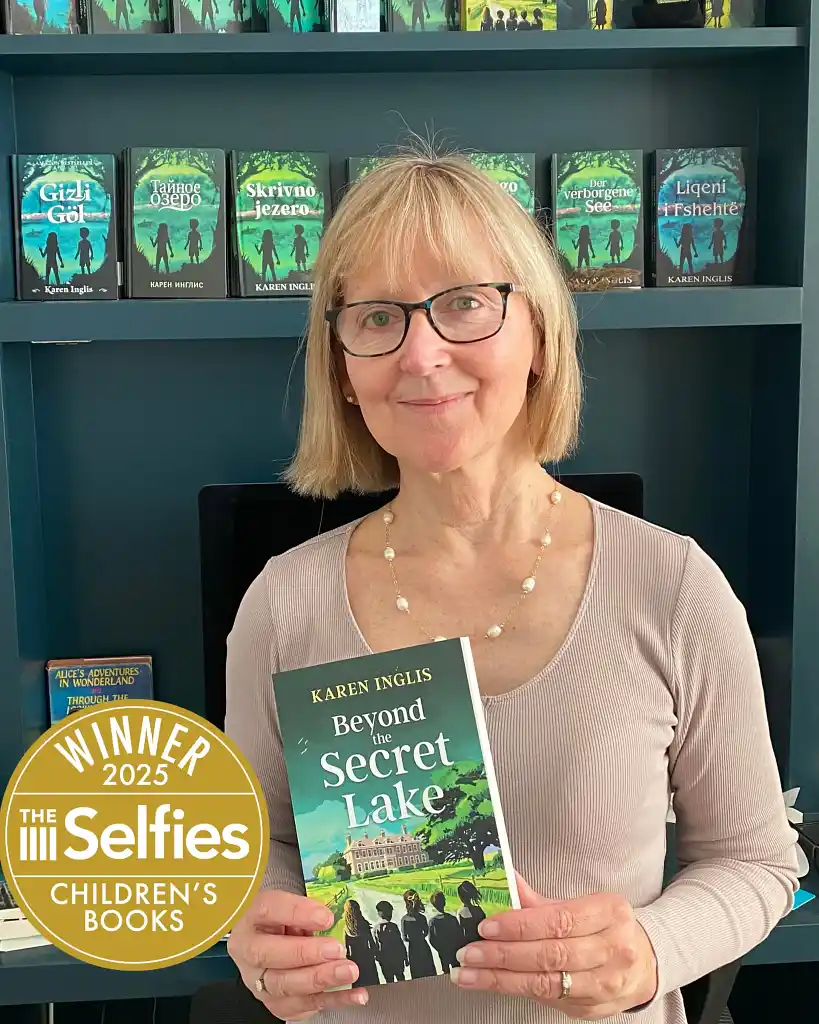 Karen Inglis is an internationally bestselling children’s author of picture books, chapter books and middle grade novels. Her time travel adventure The Secret Lake has sold over 600,000 print copies in English and is in translation in 14 languages. Her other titles have all sold in their thousands. Beyond the Secret Lake, Book 3 in the series, won the 2025 UK Selfies Children’s Book Award for best independently published children’s book in 2024. The award is announced each year at London Book Fair.
Karen Inglis is an internationally bestselling children’s author of picture books, chapter books and middle grade novels. Her time travel adventure The Secret Lake has sold over 600,000 print copies in English and is in translation in 14 languages. Her other titles have all sold in their thousands. Beyond the Secret Lake, Book 3 in the series, won the 2025 UK Selfies Children’s Book Award for best independently published children’s book in 2024. The award is announced each year at London Book Fair.
Karen has received traditional publishing offers over the years, including in 2021 from a major UK children’s publisher, but has preferred to retain creative control over her work. Her non-fiction title: ‘How to Self-publish and Market a Children’s Book’ is now in its second edition alongside a companion title ‘How to Market a Children’s Book’. A third edition is due out in late 2025/early 2026.
Karen is Children’s Advisor at the Alliance of Independent Authors.
